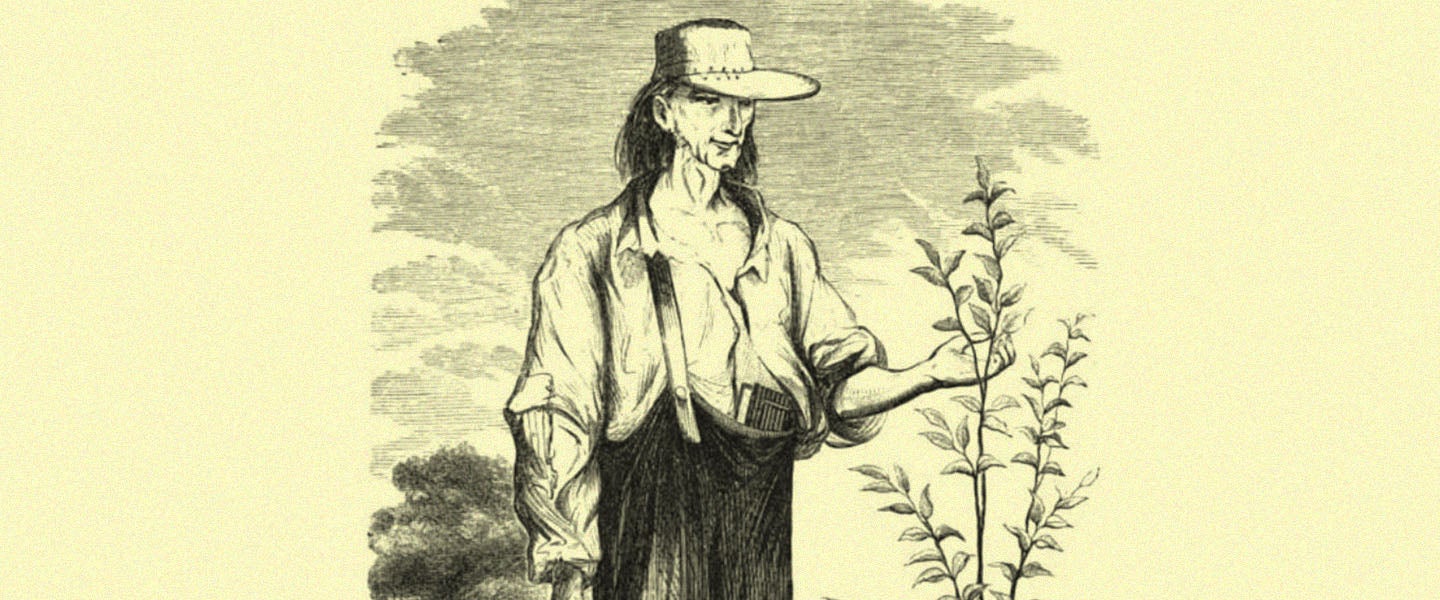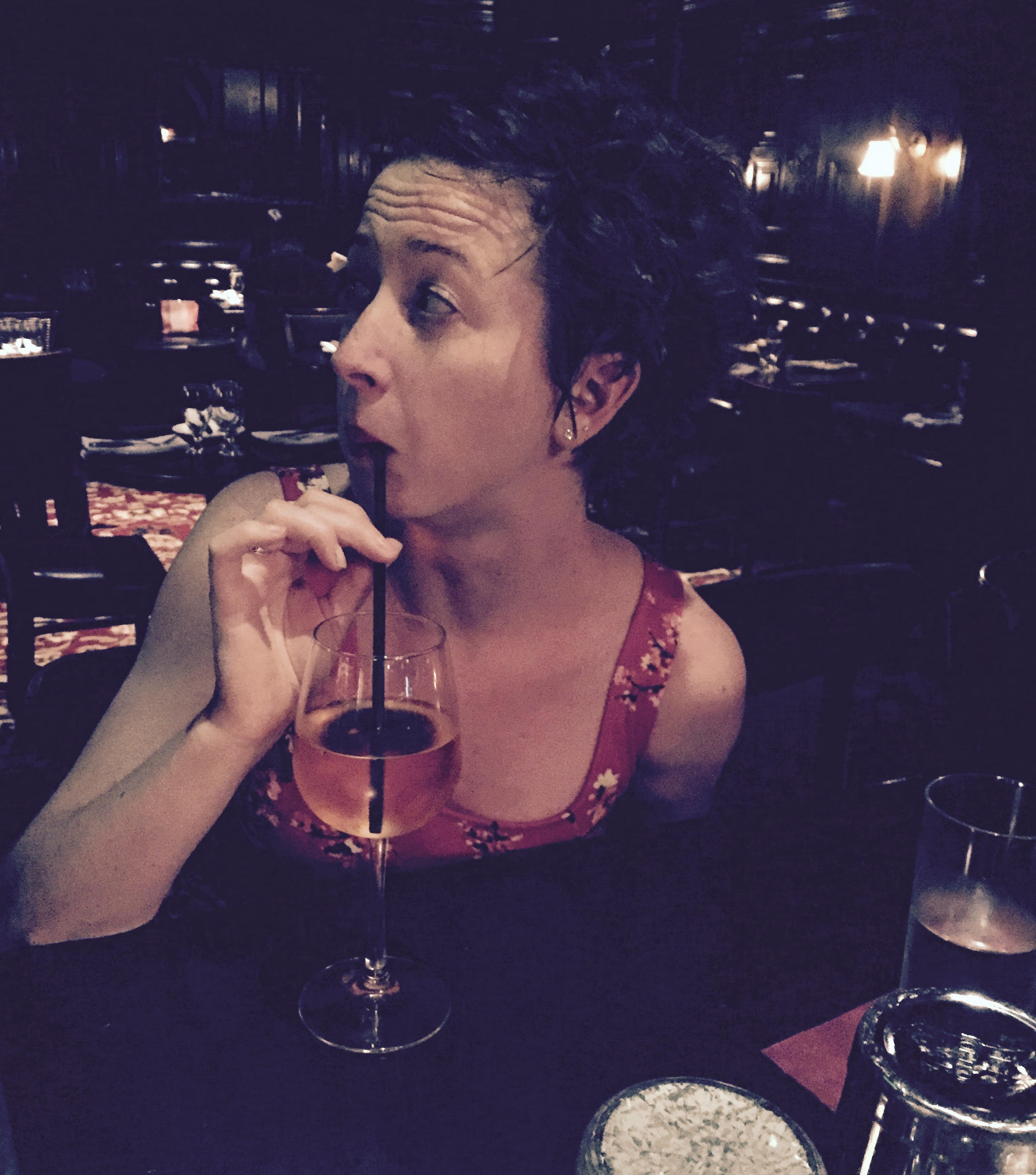In the hierarchy of American mythology, Johnny Appleseed ranks right up there with George Washington’s cherry tree and Paul Bunyan. Unlike those two legends, however, most of what we learned about Johnny Appleseed in grade school is true.
Johnny Appleseed was very much a real person, and he most certainly walked halfway across the country planting apple seeds. He was definitely as mystical and nature-loving as mythology purports him to be.
But if there’s something the Disney-fied version of Johnny’s history gets dead wrong, it’s what those apples were for.
Born John Chapman on September 26th, 1774, in Leominster, Massachusetts, Johnny Appleseed headed west, on foot, at age 23, planting apple orchards wherever he landed. By the 1830s, Chapman ran a chain of apple tree nurseries running from western Pennsylvania through central Ohio and clear into Indiana.
The trees he planted, though, would never bear edible fruit, and everyone he encountered knew it. Apples, Michael Pollan writes in Botany of Desire, the first chapter of which is dedicated to Chapman and apples, don’t “come true” from seeds: “An apple tree grown from seeds will be a wildling bearing little resemblance to its parent. Anyone who wants edible apple plants grows grafted trees.”
Johnny Appleseed didn’t believe in grafting, and he wasn’t planting apples to feed the people: He was planting trees whose fruit was exclusively turned into hard cider and sometimes applejack — a 60 proof spirit culled from freezing hard cider.
He was, essentially, an American Dionysus: a nature-loving mystic who knew the power and joy of alcohol and sought to share it with as many as people as possible. Before rum, before whiskey, hard cider was the American booze. A century ago, much of its popularity was wiped out by Prohibition. But today, cider is back.
And it’s more diverse, more accessible — and perhaps more American — than it’s ever been.

A Brief History of Cider
You can win New England in a game of Heads Up! with three words (okay, one word, but I’m tired of talking about the the Patriots): fall, apple-picking, and cider. Which makes sense: Grapes do not grow well in much of the region, but apples? Apples grow up and down both coasts, and they flourish in the Northeast.
“I feel like most people hear cider and start thinking of plaid and hayrides and leaves and New England,” Pete McCoubrey, Director of Marketing at Downeast Cider, tells me.
“Remember going apple picking when you were a kid? Back before the point of going to the farm was to get your 58 likes on Instagram and call it a day?” Pete asks. “I remember feeling like the whole point of the trip was to walk away with a donut and that styrofoam cup of apple cider — not even hard cider, just cider. I think there’s a certain nostalgia factor when it comes to New England and cider. I know the people around here are passionate about making a cider that reminds us of the cider we grew up drinking.”
Which is certainly one way of looking at it. Another is to incorporate seedling apples, like those planted by Johnny Appleseed.
“When I first started making cider, I used seedling apples because they were what we were surrounded by and they tasted really good in cider — it was kind of a happy accident,” Steve Selin of South Hill Cider in Ithaca, New York, tells me.
“Don’t eat them,” he warns. “They’re very tart and astringent. One out of 10 might be pleasant to eat, but nine out of 10 make good cider.”
Selin continues to use seedling apples in his cider to stick to what he feels is most true to the form of the beverage.
“One of the reasons I continue using them is essentially out of the purity of it,” he says. “It’s a wild foraged food. Over the past few years, there’s been more and more interest in organic and biodynamic fruit going into wine, and using wild fruit, I feel like that’s one step beyond. By using the wild fruit, you’re already sourcing it from plants that are naturally balanced, which is what organic and biodynamic farmers are really trying to do.”

Diverse Drinking
One of the most enticing qualities of hard cider today is its diversity. Some cider makers, like Downeast, are focused on evoking the flavors of straight-up apple cider. Others, like South Hill Cider, look further back to the Johnny Appleseed variety of apples.
“Cider can be so many things, and we’re just getting to know it,” says Dana Masterpolo, co-owner of Bantam Cider in Somerville, Massachusetts. “In 2012, when we launched, my partner and I looked around and everyone had their craft cocktail, their craft beer, [their] wine… and either cider wasn’t represented or not on par with what was there.
“We realized what we were doing for fun on our own was more interesting than what was currently on the market. Back then, everything was really one-dimensional; it used to be just a few really big brands. There wasn’t anything out there that showed the full range of what cider can be. So we went for it.”
Hard cider, for those unfamiliar with the drink, is in many ways closer to sparkling wine than beer. While many varieties are fermented with wild yeast, Champagne yeast is also used frequently.
The spread of options out there, then, is as diverse as wine: There are unfiltered ciders, rose ciders, dry ciders, hopped ciders; ciders fermented with apples and blueberries, apples and cranberries, apples and ginger. If you’ve ever said, “I don’t like cider,” odds are you just haven’t found one that suits you.
“What we do is driven by … a curiosity of awesome ingredients and bringing them together to make something really special,” Masterpolo says. “Making cider really diverse brings more people into it. More people are coming back to a drink that has been kind of forgotten for a while.”

Making Good Out of a Complicated History
The history of New England — in many ways the birthplace of American hard cider — is, as everyone ought to know, complicated. Sure, the forefathers drank cider and had it brewed on their farms and plantations, but they weren’t making it; slaves were. Vermont is still one of the whitest states in the country.
“There’s a lot of inherent racism in glorifying the founding fathers as cider makers. It’s really important to acknowledge that history,” says Olivia Maki, who co-owns Oakland, California’s Redfield Cider Bar and Bottle Shop with her husband, Mike Reis.
Maki and Reis have been working in and with cider since 2013, and quickly found that while cider-centric communities were cropping up in places like Seattle and Portland, Oregon, as well as in the Northeast and New York, the Bay Area didn’t have a place for cider enthusiasts to gather.
“When we started, we thought a significant portion of our sales would be beer and wine,” Maki says. “We have a pretty on-point beer and wine program, and we’ll always have that, but what we’ve found over the last five weeks we’ve been open is people really want to drink cider.
“They’ve been waiting for something like this, and they’re excited we’re open. People are clearing out our shelves; it’s incredible.”
Redfield stocks cider from across the country as well as around the world. “New England is making incredible cider, [and] so is New York. We really like to represent the cider culture of the Bay Area, but the strongest cider cultures are where the country’s best apples are grown,” Maki said.
“Cider should be a fundamental part of the cultural fabric of the Northeast in particular, and other apple-growing regions,” says Soham Bhatt of the Artifact Cider Project in Everett, Massachusetts.
“But we want to forget about words like heritage, because that shit just sounds racist,” he adds. “It was slaves making that cider for them. … It’s not about throwing away tradition, it’s taking what we like about it and removing the connotations of the past and making something new. Cider can truly be local and it can really be a reflection of a place. Our ciders reflect our place and our culture today.”
So, What Would Johnny Say?
If Johnny Appleseed is the lower-key Dionysus of early America, what would he have to say about the evolution of hard cider and the hard cider industry? I asked the experts.
Steven Selin, South Hill Cider
“In his religious beliefs, even grafting was sacrilegious, because you’re messing with God’s creation. I think he would believe it was the devil’s work.”
Soham Bhatt, Artifact Cider Project
“Okay, so John Chapman was Swedenborgian religious — there would be a lot of stuff for him to comment on. Mostly he would be in shock about how many people pay for the stuff. ‘You pay for this? We make this at home!’”
Pete McCoubrey, Downeast Cider
“One of the biggest disappointments of my entire life was when I found out that Johnny Appleseed was actually a guy named John Chapman. Johnny Appleseed makes sense, doesn’t it? You’re born with the last name Appleseed, and suddenly it makes a lot of sense to throw a pot on your head and start planting apple trees. John Chapman, though? I’m not sure about John Chapman. Sounds like a cop or an accountant or the real name of a criminal who went by Lefty. That said, I think Johnny Appleseed would love our cider. A guy walking around with kitchenware as a hat and no shoes on would probably be a little bit turned off by the economic competition in the industry, but he’d have his reasons. John Chapman? Can’t say. He’d probably be very bent out of shape about corn syrup right now.”

